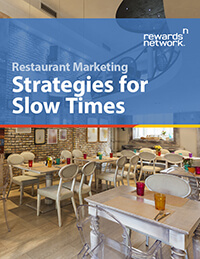The ability to turn a profit at any restaurant depends on one thing and one thing only:
Filling seats.
So when you have a full staff, a kitchen full of food, and no one in your dining room, it’s time to get creative. We have five restaurant marketing strategies that can fill in the gaps during slow times, with little to no impact on your core restaurant business:
- Seasonal LTOs
- The Business Lunch
- Happy Hour
- A Tasting Menu
- Parties and Catering
Download this free eBook today to see how these five new restaurant marketing strategies to attract new customers and keep them coming back for more.
Excerpt from Chapter 5:
One surefire way to increase your restaurant sales without disturbing your core customer experience is to host larger parties at your restaurant, in a separate designated room — or even offsite through catering events. This is a particularly good tactic for those summer months of “dads and grads” where regular traffic may start to ease off.
Private parties can be offered a limited service menu to order from. A limited service menu will help you control costs and reduces the possibility that the kitchen will be over-taxed by many different orders needing to be prepared and served simultaneously.
Since parties and other catered events are typically booked in advance, your chef will have advance warning about the amount of food the kitchen will need to stock and prepare, limiting unnecessary waste.
And hosting large parties in your own enclosed space can help control staffing as well. Buffet or family-style serving limits the number of servers necessary to keep these important guests happy. As larger parties tend to be faster to manage than multiple tables of the same total number of guests, you’ll be able to handle more guests over the course of an evening shift.
This is also your opportunity to serve guests who may never have been exposed to your restaurant — guests that now have insight into what you can offer in a full-service setting. Those word of mouth recommendations from party-goers can be very positive for your reputation overall, and it’s easy to see how party-goers can turn into regular customers as well.
Where do you think guests would prefer to hold their holiday celebrations, bridal showers, corporate events, and civic meetings: A large table surrounded by other guests, clanking silverware, and rushing servers; or a quiet area with dedicated servers, décor, and dishes?
At first glance, it may seem easier — and more cost-effective — to simply put large parties at their own table tucked away from the action. But by using (or building out) a special space, you’re doing much more than accommodating groups of 8 or 10 — you’re creating an entirely new, and very lucrative, facet to your business. And it typically requires fewer servers to satisfy a large group sitting together than an equal number of people, separated into several tables.
Although they may see your private party spaces, it may not occur to your guests that your restaurant would be the prime spot for their event. That’s why you have to get the word out — and the best way to do so is to go straight to the source.
Contact party planners, wedding dress boutiques, and other event vendors in your area to ask them to help promote your services. Visit local sports teams or organizations and encourage them to hold meetings, celebrations, or award ceremonies with you. You can even contact hotels and tour companies in the area to get the word out that large groups are welcome in your event spaces.
And, as more and more people plan parties through Facebook and share their photos on Instagram, don’t forget to broadcast your message on social media.
Although smaller parties can typically order from your everyday menu, you will want to consider special, limited-service menus for any large groups. Meet with your chef and determine which dishes would not only present well to these groups, but can also be prepared and served large scale without over-taxing your kitchen — an especially important consideration if you intend to have normal service hours in your public dining room during the party.
If you and your kitchen staff are comfortable with experimenting, you can even develop multiple menus to offer to party organizers, based on the type of event they’re hosting.
For larger gatherings, you may want to consider a buffet-style meal, putting less strain on every member of your staff and allowing your guests to help themselves — and even go back for seconds.
Be aware: there are likely more than a few items on your current menu that cannot withstand pre-prep, transport, and reheating required for an offsite catering venue.
That’s why it’s important to develop a catering-specific menu full of dishes that are perfectly suited to large-scale production and transport.
It’s important to also get a feel for the demand in your market. Are you located near an office park, where sandwiches, soup, or warm comfort classics could play well at lunch time? Are you in a residential area, where formal events like bridal showers or large-scale parties like family reunions may make up most of your business?
